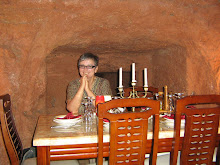
I haven't been inside the auberge de Castille before. It is where parliament sits and it is not usually open to the public. So when I spotted the notice saying that the history society were going to do a lecture in the Ambassadors' room, I figured it was a good opportunity to look inside. The lecture was on the arms and armour of the great siege.
I arrived early and some people were gathering on the steps outside the auberge. Two huge canons are mounted at either side of the door at the top of the steps. Promptly at 6.45 a man in uniform opened the doors and said we could go in. The doors enter directly onto a massive stone stairway and we were directed to take the right wing of these stairs. The Ambassadors' room was set up as a lecture room with two video screens on either side of the speaker's table. The ceiling is more than two stories high and has timber cross beams in a square pattern. There are textile hangings of coats of arms high on the walls and very tall french doors.
The lecture was given by Dr Steven Spiteri who has recently published drawing on his PhD work on the Great Siege. This was the second lecture in a series on this topic. Arms and armour is not really a great love of mine but some of the detail about the organisation of the opposing forces was interesting. The knights were trained to fight as individuals rather than strategically as an army and although firearms were introduced, they were slow and clumsy and had to be supported by more traditional weapons such as the crossbow, sword and pike. Flint-lock muskets were a very slow and vulnerable process and each musketeer had to be protected by two pikesmen.
The cavalry were mostly Maltese noblemen who could afford to provide their own horses and equipment. Combined cavalry and infantry patrols would be sent out from Mdina for reconnaisance and attack of foraging parties from the Turkish camps. The knights fought mostly on foot so they sacrificed their lower body armour in favour of mobility. The knights also provided their own armour and then left it to the armoury when they died. Double-handed swordsmen were paid extra and were kept in reserve for close combat.
In the Turkish camp, the janissaries were the professional infantry and used projectile weapons and swords as individual warriors. They fought on their own terms and were so unruly that the Turks had to disband them in later years to enable a modern army where people took orders. Their armour was designed for mobility and swift attacks, so they were at a disadvantage in siege situations. The Turkish bow was not effective in piercing armour.
Turkish numbers were exaggerated by the reports from the knights and these reports had to be toned down when the knights were trying to persuade other nations to send support. Both the knights and the Turks wore a covering over their armour - robes for the Turks and a tabard with the red and white cross for the knights.
Dr Spiteri closed his talk by wondering why there was such a dearth of artifacts left behind by the Turks. After such a major siege there would certainly have been a great many objects left behind but very little is now left. What happened to them?
The photo was taken on Monday in Carnival Valletta. What story would you tell?

No comments:
Post a Comment